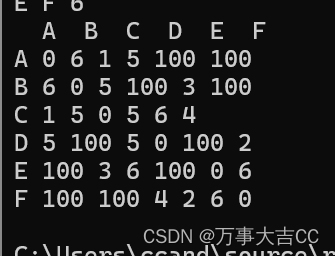
解法:
总结起来,Prim算法的核心思想是从一个顶点开始,一步一步地选择与当前最小生成树相邻的且权值最小的边,直到覆盖所有的顶点,形成一个最小生成树。

#include<iostream>
#include<vector>
using namespace std;
typedef struct
{int n;int e;char data[500];int edge[500][500];
}Graph;
typedef struct
{int index;int cost;
}mincost;
typedef struct
{int x;int y;int weight;
}EDGE;
typedef struct
{int index;int flag;
}F;
void create(Graph& G, int n, int e)
{int i, j, k, w;char a, b;for (i = 0; i < n; i++)cin >> G.data[i];for (i = 0; i < n; i++)for (j = 0; j < n; j++){if (i == j)G.edge[i][j] = 0;elseG.edge[i][j] = 100;}for (k = 0; k < e; k++){cin >> a;cin >> b;cin >> w;for (i = 0; i < n; i++)if (G.data[i] == a) break;for (j = 0; j < n; j++)if (G.data[j] == b) break;G.edge[i][j] = w;G.edge[j][i] = w;}G.n = n;G.e = e;
}
void Prim(Graph& G, int k)
{vector<mincost> closed(G.n);closed[k] = { -1,0 };for (int i = 0; i < G.n; i++) {if (i != k) {closed[i] = { k,G.edge[k][i] };}}for (int i = 1; i < G.n; i++) {mincost t = { 0,100 };for (int j = 0; j < G.n; j++) {if (closed[j].index!=-1&&closed[j].cost!=100)if (t.cost > closed[j].cost) {t.index = j;t.cost = closed[j].cost;}}char a = G.data[closed[t.index].index];char b = G.data[t.index];cout << '(' << a << ',' << b << ')';closed[t.index] = { -1,0 };for (int m = 0; m < G.n; m++) {if (closed[m].cost > G.edge[t.index][m])closed[m] = { t.index,G.edge[t.index][m] };}}
}
int main()
{Graph my;int n, e;cin >> n >> e;create(my, n, e);Prim(my, 0);return 0;
}

—集成炫酷的粒子特效)







 默认QtWidget应用包含什么?)






:快启)

